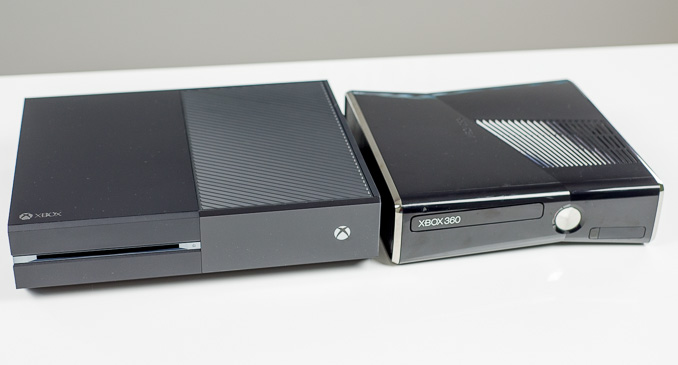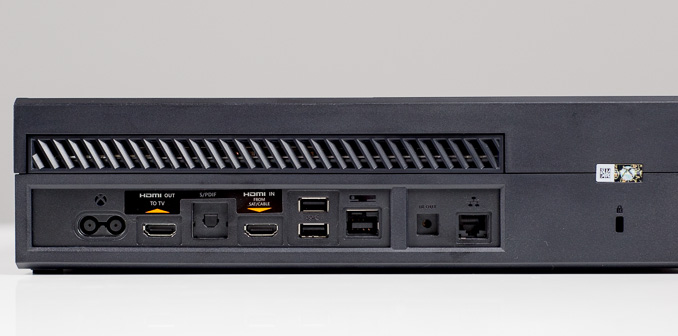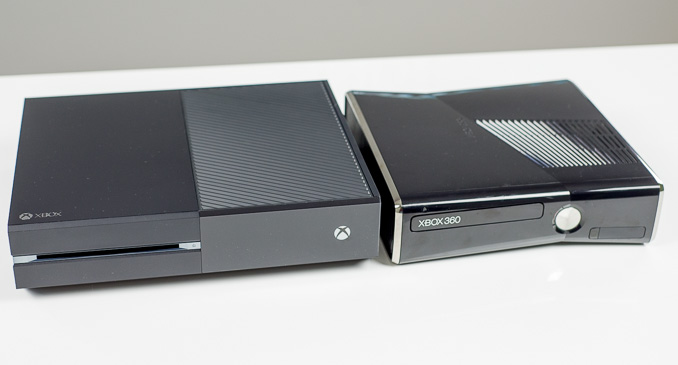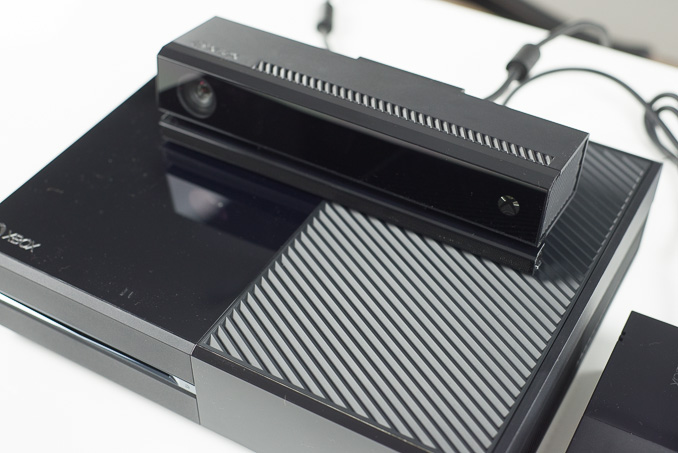The Xbox One - Mini Review & Comparison to Xbox 360/PS4
by Anand Lal Shimpi on November 20, 2013 8:00 AM EST
Earlier this morning Microsoft lifted the embargo on press reviews of the Xbox One. I’ve been playing with final hardware and near final software for a few days now and I wanted to share some thoughts. This is by no means one of our usual thorough review jobs, just a side quest I found myself on over the past few days.
I like the look of the Xbox One. I wish it felt a little more durable, but perhaps that’s the mobile side of me speaking where materials are a bigger deal. Sitting on a stand, desk or rack from across the room the One looks clean, simple and honestly, it looks like an Xbox. The Xbox 360 was a journey into a weird sort of industrial design that was a significant departure from the original. The past couple of revisions of the 360 have moved towards sharper angles and away from the curves of the original 360. The One completes the journey back to its roots. Dare I say it almost looks like a PC, and if you crack open the chassis you’ll be reminded of the same.
I’ll start with IO on the sides and back. There’s a single USB 3.0 port on the left side of the chassis, with two more on the rear of the machine. Support for external storage is apparently on its way, as the Xbox One doesn’t allow end user upgrades of the internal 500GB hard drive. I have to say that I prefer Sony’s stance on this one.
Gigabit Ethernet and dual-band 802.11n WiFi handle Internet connectivity. I’m still shocked that the PS4 shipped with 2.4GHz only WiFi in 2013. On the AV front there’s an optical output and HDMI in/out. Kinect has its own port on the rear of the chassis and there’s an IR port as well. There’s a Kensington security slot to the right of all of the IO on the Xbox One.
The ring of light from the Xbox 360 is gone and replaced with a single, white, backlit Xbox logo on the front of the console. You’ll notice the controller position indicators are gone as well (not only from the One, but from the controllers themselves). A combination of the Kinect camera that comes with every Xbox One and IR transceivers in every controller is all you need to figure out player/controller mapping. Indeed, the Xbox One can actually log you into your appropriate Xbox Live account based on recognizing your face alone. I set the One up at my work area, so I had to awkwardly position my face in front of the Kinect camera to make the auto login work but if you’ve got a more normal setup I can see this being supremely convenient. If you live in a household with multiple Xbox users, the facial login will be one of the standout features of the new console. There’s a quick training process that you have to go through to have the console recognize your face, but after that I never had any issues with using my face to log me in. As long as I was sitting in front of the Kinect camera, I sort of forgot about needing to log in, it always just happened for me.
It’s very obvious to me that proper cooling and quiet operation were top priorities for the Xbox One. Big portions of the One’s top are covered in vents to provide air for the large fan inside. Plastic grills adorn the sides as well. The One is larger than the PlayStation 4, despite having a lower system TDP, but the chassis size is designed to keep the internals cooler and the system quieter. It’s a tradeoff we’ve seen time and time again. While I do appreciate the PS4’s size and fully expected the Xbox One to seem huge, it absolutely doesn’t in practice.
I won’t talk too much about the Xbox One’s HDMI input. I cut the cord a few years ago, so I’m not really in the best position to comment on cable TV set-top box integration with the Xbox One. What I will say is the One’s HDMI input can really be used for anything. In testing the One, I actually had my PS4 plugged in to the HDMI input and could quickly switch between consoles simply by saying “Xbox Watch TV”. The HDMI input properly (read: legally) handles HDCP content, so by default you can’t use it to circumvent the HDCP protection that’s enabled on the PS4 at launch unfortunately. The One’s HDMI output only applies HDCP to content that needs it. The dashboard, most apps and games stream through unencrypted. Unlike the PS4, the Xbox One does not support HDMI-CEC, relying instead exclusively on IR blasting to turn on your TV and cable box (if applicable).
Kinect and voice control are big parts of the Xbox One experience. Since every Xbox One comes with a Kinect in the box, developers can count on a 3D camera and always-on mic whenever they sell to an Xbox One customer. The early titles that I’ve played don’t really do a great job leveraging either of these things, but I suspect we’ll see some clever use cases in the future. I’ve never been a big Kinect user, but I did use the Xbox One’s voice control quite a bit. Just to set expectations, voice interaction with the Xbox isn’t as natural as what you’d see on an episode of Star Trek: TNG, but it’s not bad either. I found myself using voice as an augmentative interface rather than something I replaced the controller with. In fact, I typically used voice control as another pair of hands to deal with the Xbox One’s UI while I’m off doing something else. For me it was always quicker to hit the Xbox button to go home rather than telling the Xbox to go home, but for things like recording a clip of the last 30 seconds of gameplay the voice integration is irreplaceable. More than a few times I’d be particularly proud of something I did in Killer Instinct or Call of Duty, call out Xbox, record that, and it would immediately dump the last 30 seconds of gameplay into a temporary buffer. All of this would happen with no impact to game frame rate or performance. I’d just have to remember to go back into the Game DVR and actually save/commit these recordings otherwise they’d eventually be overwritten if I kept going. Unfortunately Microsoft’s Upload studio, the application needed to share these recordings, won’t be available until the official launch of the console so we’ll have to wait and see how all of that turns out.
I feel like we’re heading in the right direction as far as voice recognition goes, but we’re not quite there yet. The voice integration on the One still feels awkward and doesn’t make good use of natural, conversational language. I don’t want to feel like I’m issuing commands to my console, I want to sort of ask it to do things for me in whatever way I want and to have it respond accordingly. Hey Xbox, start downloading Dead Rising 3 and I want to play Battlefield 4 in the meantime - get me there and we’re in business.
One feature I absolutely loved using the Kinect camera for was to read QR codes to activate downloads in the Xbox Store. Recognition is extremely quick and it keeps me from having to type on the miserable on-screen keyboard (with no word suggestions like the PS4 nonetheless).
Those concerned about their privacy will be happy to know that Kinect isn’t required for use. You can boot the console and use it just fine even if you never connect Kinect. While at the dashboard you will get a little message telling you that Kinect is unplugged however.
The UI and Multitasking
The Xbox UI is much improved over its predecessor. Multitasking is no longer a painful endeavor. You can quickly move between playing a game, changing settings or even messing around with other applications. If anything, the most visible feature of the next-generation of game consoles is just how much better multitasking is. On the Xbox 360 if you wanted to mess around with any console settings while in a game you’d have to physically quit the game, and in some cases even log out of Xbox Live. With the One it’s all a matter of suspend and resume. It’s quick, unobtrusive and tremendously less frustrating.
Multitasking is also far less of a performance hog than on the 360. For starters the One has a ton of x86 cores to handle multitasking (8 total, I believe 2 of which are dedicated to OS work), and it’s now running two independent OSes with a hypervisor managing both. The results are quite evident. If you’re coming from a 360, you’ll appreciate better graphics in games today, but you’ll probably love the fact that you no longer have to fight the UI as much.
It’s not all roses though. I can definitely get the UI to drop frames, particularly when using the One’s new snap feature that lets you display two things on the screen at once. GPU power is time sliced between the the Windows kernel and Xbox OS (10% allocated to the Windows kernel). Microsoft hopes to eventually offer that remaining 10% up to game developers as well, but we’re not there yet. The time slice is quite obvious when you’re playing a game and Xbox notifications slowly animate at the bottom of the screen. When things do get sluggish however, the One mostly seems to drop UI frames and avoids increasing response time. I always dreaded doing anything while playing a game on the 360, the same is no longer true on the One.
The Xbox One’s UI isn’t always incredibly straightforward either. It’s good that Microsoft has been able to so quickly embrace and deploy a common UI across all platforms, but I’m not sure that it’s necessarily the best UI out there. There’s a large horizontal list of tiles, reminiscent of Windows 8. You can pin individual tiles to the left side of the dashboard, and depending on what screen you’re in the order of the tiles may vary depending on what you’ve done most recently. Transitions between tiles are also a bit odd. I expect to go into a tile when I select it, but in most cases the display will scroll up, transitioning to a new “window” when I activate a tile. The other thing I’d say is the tiled interface isn’t particularly pretty. Go into the movie, music or game stores and you get these beautifully integrated photos and artwork, but the bulk of what you stare at in the Xbox One UI are big blocks of color. I would’ve loved to have seen a more dramatic reimagining of what this could be (although it’s still worlds better than the Xbox 360’s UI).
The Controller

The Xbox One supports up to 8 wireless controllers, one of which is included in the box. By default the controllers take two AA batteries, although Microsoft will offer optional first party rechargeable batteries at launch. I didn’t get time to build a good battery life test for the One’s controllers, but Microsoft tells me you should expect somewhere around 30 hours of use on a single set of AAs.
The new controller is a clear evolution of the 360’s controller. There are three features that stood out to me in using the controller. For starters, the amount of initial resistance in each thumbstick has been dialed back considerably. The new thumbsticks are easier to use and less fatiguing as a result. Secondly, the new d-pad ditches the silly old platform that the old d-pad rested on. Instead you get a standard plus-arrangement. Each direction is accompanied by a shallow but pronounced click. It’s great for using the d-pad for issuing commands, but for fighting games I’d prefer something a little softer rather than discrete clicks. I feel like Microsoft likely picked the right tradeoff here as the days of Street Fighter, Mortal Kombat and Killer Instinct are long behind us, despite the latter making another appearance on the One.
The final improvement to the controller is the inclusion of what Microsoft is calling impulse triggers. The One’s controller features a total of four vibrating motors, one in each grip and one in each of the two big triggers (LT/RT). For games that choose to implement it, impulse trigger support is awesome. You get a subtle rumble that’s very focused on the triggers rather than your whole controller vibrating like crazy. I feel like force feedback in controllers is obviously here to stay, but it’s rarely used in a particularly subtle fashion. Instead what you normally run into is short bursts of feedback or long, agonizing vibration. NBA 2K14 appears to use the impulse triggers and the result is something in between, and something I really did appreciate.
For the first time since the introduction of the Xbox, Microsoft has done away with the back/start buttons and instead replaced them with view and menu buttons. They more or less serve the same functions, it’s just interesting to me how every major generation we come across an obvious desire to ditch select/start.



















286 Comments
View All Comments
elerick - Wednesday, November 20, 2013 - link
Thanks for the power consumption measurements. Could the xbox one standby power be higher due to power on / off voice commands?althaz - Wednesday, November 20, 2013 - link
I suspect this is almost certainly the case. I wonder if it drops down below 10w if you turn off the Kinect (which I would never do myself)?I also hope Sony update their software - the Xbox stays in the 16-18w range when downloading updates, whereas the PS4 jumps up to 70 (70w when in standby and downloading an update, but still takes 30 seconds to start up!).
mutantsushi - Saturday, November 23, 2013 - link
It seems that the PS4's extremely high standby/download power draw is due to the ARM co-processor not being up to the task, it was supposed to be able to handle basic I/O tasks and other needed features, but apparently it wasn't quite spec'd sufficiently for the task, forcing Sony to keep the main CPU powered on to handle that task. The rumor is that they will "soon" release a new revision with a more powerful ARM core that is up to the task, and which should allow powering down the x86 CPU completely, as per the original plan. (either that, or managing to rework the "standby" software functions so that the existing ARM core can handle it would also do the trick)I believe MS is now also rumored to "soon" release a revision of the Xbone, although what that might entail is unknown. An SKU without the Kinect could allow them to drop the price $100 to better compete with PS4.
Incidentally, the Xbone seems to be running HOTTER than the PS4, so MS' design certainly cannot be said to be a more efficient cooling design, more like they have more open space which isn't being efficiently used compared to PS4's design. The temp differential is also probably down to MS' last minute decision to give a 5% clockspeed bump to the APU.
I'm looking forward to the 'in depth' article covering each. As far as performance is applicable in actual use scenarios, i.e. games, I'm interested to get the real low-down... The vast similarity in most aspects really narrows the number of factors to consider, so the actual differentiating factors really should be able to comprehensively addressed in their implications.
Like Anand says, I don't think memory thru-put is a gross differentiator per se, or at least we could say that Xbone's ESRAM can be equivalent under certain plausible scenarios, even if it is less flexible than GDDR and thus restricts possible development paths. For cross-platform titles at least, that isn't really a factor IMHO.
The ROP difference is probably the major factor for any delta in frame buffer resolution, but PS4's +50% compute unit advantage still remains as a factor in future exploitability... And if one wants to look at future exploitability then addressing GPU and PS4's features applicable to that is certainly necessary. I have seen discussion of GPGPU approaches which essentially can more efficiently achieve 'traditional graphics' tasks than a conventional pure GPU approach, so this is directly applicable to 'pure graphics' itself, as well as the other applications of GPGPU - game logic/controls like collisions, physics, audio raycasting, etc.
When assessing both platforms' implications for future developments, I just don't see anything on Xbone's side that presents much advantage re: unique architectural advantages that isn't portable to PS4 without serious degradation, while the reverse does very much present that situation. While crossplatform games of course will not truly leverage architectural advantages which allow for 'game changing' differences, PS4's CU, ROP, and GPGPU queue advantages should pretty consistently allow for 'turning up the quality dial' on any cross-platform title... And to the extent that their exploitation techniques becomes widely used, we could in fact see some 'standardizd' design approachs which exploit e.g. the GPGPU techniques in ways easily 'bolted on' to a generic cross platform design... Again that's not going to change the ultimate game experience, but it is another vector to increase the qualitative experience. Certainly in even the first release games there is differences in occlusion techniques, and this is almost certainly without significant exploitation of GPGPU.
mutantsushi - Saturday, November 23, 2013 - link
If Xbone's resolution is considered satisfactory, I do wonder what PS4 can achieve at the same resolution but utilizing the extra CU and GPGPU capacity to achieve actually unique difference, not just a similar experience at higher resolution (i.e. 1080 vs. 900). If 900 upscaled is considered fine, what can be done if that extra horsepower is allocated elsewhere instead of increasing the pixel count?errorr - Wednesday, November 20, 2013 - link
That is still ridiculous considering the moto x and some other future phones can do the same thing at order of magnitudes less power draw.Teknobug - Wednesday, November 20, 2013 - link
I love my Moto X, X8 8-core processor means each core has its own job, 1 core for always listening and 1 core for active notifications. Very easy on the battery, which is why it is one of the best battery life phones right now.uditrana - Thursday, November 21, 2013 - link
Do you even know what you are talking about?blzd - Thursday, November 21, 2013 - link
Moto X is dual core. x8 is a co processor not eight cores.errzone - Monday, November 25, 2013 - link
That's not entirely true either. The Moto X uses the Qualcomm MSM8960. The SOC is a dual core processor with an Adreno 320 GPU, which has 4 cores. Adding the 2 co-processors equals 8; hence Motorola marketing speak of X8.Roy2001 - Wednesday, December 11, 2013 - link
Kinect?